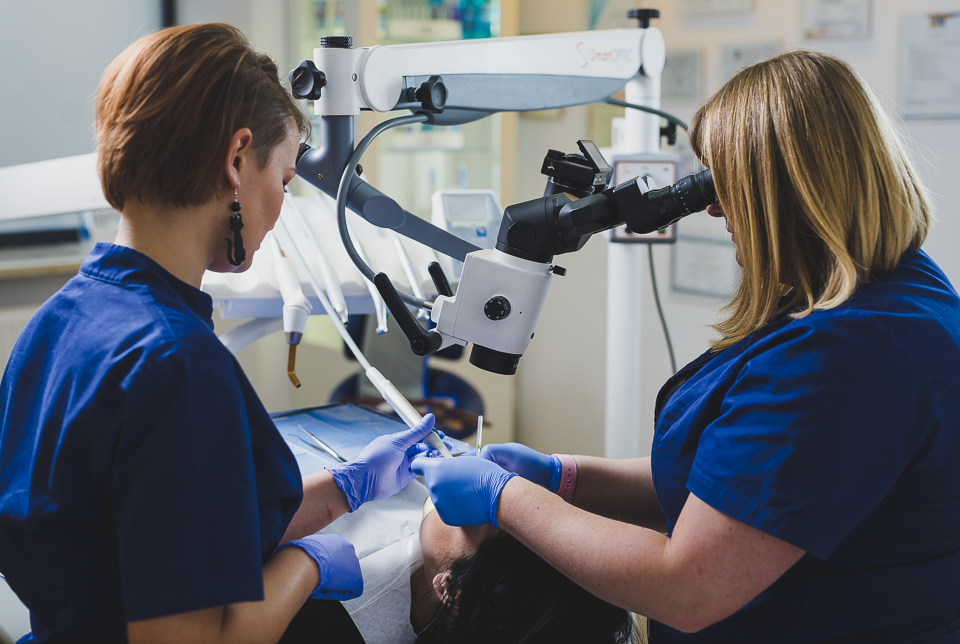Endodontics – root canal under the microscope

Untreated carries and advanced oral cavity diseases might lead to bacteria penetrating the interior of teeth and cause dental pulpitis, i.e. the inflammation of the nerve responsible for tooth’s proper nutrition and functioning.
Moreover, bite overload resulting from malocclusion or the lack of adjoining teeth might lead to tooth’s death and require endodontic, i.e. root canal treatment.
What is endodontic treatment?
Endodontic treatment requires cleaning root canals of bacteria and dead tissue, after which canals are property shaped with the use of NiTi modern tools and then filled with warm gutta-percha, which ideally fills all parts of the canals as well as side canals.
In our clinic we use a modern X-Smart Plus micromotor in order to shape the canals in the form of a cone.
Depending on the shape of the canal we use various machine tools, among others – Mtwo, WaveOne and Race.
To measure length to which canals should be treated, an endometer is used, which gives proper measurements with the accuracy to 0,1mm.
The clinic is equipped with two Raypex 5 endometers, which allow for the precise measurement of root canals.
The filling is controlled with an x-ray taken with ZEN-X by MyRay, which significantly lowers ionizing radiation. Each root canal treatment should be completed with an x-ray. Since radiograph is mounted on dental chair, the x-ray can be taken without moving to another room, which might be uncomfortable to the Patient.
Root canal treatment used to be associated with pain and numerous visits to the dentist’s. Such treatment lasted months and the results were far from ideal. Modern endodontic treatment has no such flaws.
At present treatment is carried out on one or two visits. In rare cases a greater number of visits would be necessary. Anaesthesia is used, which makes treatment painless.
A dental dam is used to separate tooth from oral cavity, which makes the oral cavity dry and the doctor can see the interior of the tooth perfectly, whereas the Patient can swallow saliva safely and freely.

Another innovation is the use of a dental microscope. “You can treat only what you see” – the words of one of the most widely known endodontists – prof. Kima, perfectly illustrate the rules of modern endodontics.
Our Clinic is equipped with Seliga Smart Optic microscope, which allows for the picture to be increased up to 22 times. Thanks to such a great enlargement of the area, our doctors are able to see even the slightest details of tooth anatomy. The microscope enhances the accuracy of the treatment, therefore, in Endodentica we use it during every root canal treatment without additional charges.
Why is a dental microscope used in root canal treatment?
 Teeth protected with a dental dam.
Teeth protected with a dental dam.
The use of microscope allows for the precise localization of canals, including additional canals that used to be untreated and led to treatment failures. The microscope helps to see what the naked eye can’t.
A dental microscope makes it easier to treat difficult canals. It enables the removal of broken canal tools, which may hamper the treatment. It is also used in procedures in endodontic microsurgery, such as root resections, covering root perforations or hemisections.
What is the forecast after root canal treatment?
That depends on the initial state of a tooth. In case of primary treatment of the tooth that has not been treated previously, the prognosis is very good, and properly treated and rebuilt tooth might serve several more years.
In case of secondary treatment and inflammation at root tops, prognosis depends on the advancement level of changes, however, with proper treatment it is still good.
It is necessary to remember that proper root canal does not guarantee success. Tooth after endodontic treatment is often weakened due to significant tissue damage and their fragility. Unprotected might be easily broken, which may lead to it being removed. Therefore, it is very important that the tooth be protected prosthetically with a prosthetic crown or composite filling covering the entire chewing area of the tooth.
